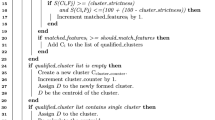Abstract
Cluster analysis is a useful tool for data analysis. Clustering methods are used to partition a data set into clusters such that the data points in the same cluster are the most similar to each other and the data points in the different clusters are the most dissimilar. The mean shift was originally used as a kernel-type weighted mean procedure that had been proposed as a clustering algorithm. However, most mean shift-based clustering (MSBC) algorithms are used for numeric data. The circular data that are the directional data on the plane have been widely used in data analysis. In this paper, we propose a MSBC algorithm for circular data. Three types of mean shift implementation procedures with nonblurring, blurring and general methods are furthermore compared in which the blurring mean shift procedure is the best and recommended. The proposed MSBC for circular data is not necessary to give the number of cluster. It can automatically find a final cluster number with good clustering centers. Several numerical examples and comparisons with some existing clustering methods are used to demonstrate its effectiveness and superiority of the proposed method.
































Similar content being viewed by others
References
Banerjee A, Dhillon IS, Ghosh J, Sra S (2005) Clustering on the unit hypersphere using von Mises-Fisher distributions. J Mach Learn Res 6:1345–1382
Bartels R (1984) Estimation in a bidirectional mixture of von Mises distributions. Biometrics 40:777–784
Carta C, Bueno JA, Ramirez P (2008) Statistical modeling of directional wind speeds using mixtures of von Mises distributions. Energy Conserv Manage 49:897–907
Chang-Chien SJ, Yang MS, Hung WL (2010) Mean shift-based clustering for directional data. In: Proceedings of third international workshop on advanced computational intelligence, pp 367–372
Cheng Y (1995) Mean shift, mode seeking, and clustering. IEEE Trans Pattern Anal Mach Intell 17:790–799
Comaniciu D, Meer P (2002) Mean shift: a robust approach toward feature space analysis. IEEE Trans Pattern Anal Mach Intell 24:603–619
Corcoran J, Chhetri P, Stimson R (2009) Using circular statistics to explore the geography of the journey to work. Papers Reg Sci 88:119–132
Cristianini N, Shawe-Taylor J (2000) An introduction to support vector machines. Cambridge University Press, Cambridge
Dempster AP, Laird NM, Rubin DB (1977) Maximum likelihood from incomplete data via the EM algorithm (with discussion). J Roy Stat Soc Ser B 39:1–38
Dortet-Bernadet JL, Wicker N (2008) Model-based clustering on the unit sphere with an illustration using gene expression profiles. Biostatistics 9(1):66–80
Fashing M, Tomasi C (2005) Mean shift is a bound optimization. IEEE Trans Pattern Anal Mach Intell 27:471–474
Filippone M, Camastra F, Masulli F, Rovetta S (2008) A survey of kernel and spectral methods for clustering. Pattern Recogn 41:176–190
Fisher NI (1993) Statistical analysis of circular data. Cambridge University Press, Cambridge
Fukunaga K, Hostetler LD (1975) The estimation of the gradient of a density function with applications in pattern recognition. IEEE Trans Inf Theory 21:32–40
Gao KS, Chia F, Krantz I, Nordin P, Machin D (2006) On the application of the von Mises distribution and angular regression methods to investigate the seasonality of disease onset. Stat Med 25:1593–1618
Kobayashi T, Otsu N (2010) Von Mises-Fisher mean shift for clustering on a hypersphere. In: Proceedings of the 20th international conference on pattern recognition, ICPR 2010, pp 2130–2133
Lee A (2010) Circular data, WIREs. Comput Stat 2:477–486
Mardia KV (1972) Statistics of directional data. Academic Press, London
Mardia KV, Jupp PE (2000) Directional statistics. Wiley, New York
Mardia KV, Sutton TW (1975) On the modes of a mixture of two von Mises distributions. Biometrika 62:699–701
McGraw T, Vemuri BC, Yezierski B, Mareci T (2006) Von Mises-fisher mixture model of the diffusion ODF. In: Proceedings of the 3rd IEEE international symposium on biomedical imaging: from Nano to Macro, pp 65–68
McLachlan GJ, Basford KE (1988) Mixture models: inference and applications to clustering. Marcel Dekker, NY
Mooney JA, Helms PJ, Jolliffe IT (2003) Fitting mixtures of von Mises distributions: a case study involving sudden infant death syndrome. Comput Stat Data Anal 41:505–513
Schölkopf B, Smola A, Müller K (1998) Nonlinear component analysis as a kernel eigenvalue problem. Neural Comput 10:1299–1319
Silverman BW (1998) Density estimation for statistics and data analysis. Chapman and Hall, New York
Spurr BD, Koutbeiy MA (1991) A comparison of various methods for estimating the parameters in mixtures of von Mises distributions. Commun Stat Simul Comput 20:725–741
Stephens MA (1969) Techniques for directional data. Tech. Report #150, Department of Statistics, Stanford University, Stanford
Thang ND, Chen L, Chan CK (2008) Feature reduction using mixture model of directional distributions. In: Proceedings of the 10th international conference on control, automation, robotics and vision, ICARCV, pp 2208–2212
Vapnik VN (1998) Statistical learning theory. Wiley, New York
Von Mises R (1918) Uber die die “Ganzzahligkeit” der Atomgewicht und verwandte Fragen. Physikal Z 19:490–500
Watson GS, Williams EJ (1956) On the construction of significance tests on the circle and the sphere. Biometrika 43:344–352
Wu KL, Yang MS (2007) Mean shift-based clustering. Pattern Recogn 40:3035–3052
Yang MS, Pan JA (1997) On fuzzy clustering of directional data. Fuzzy Sets Syst 91:319–326
Acknowledgments
The authors would like to thank the anonymous referees for their helpful comments in improving the presentation of this paper. This work was supported in part by the National Science Council of Taiwan, under Grant NSC-99-2118-M-033-004-MY2.
Author information
Authors and Affiliations
Corresponding author
Rights and permissions
About this article
Cite this article
Chang-Chien, SJ., Hung, WL. & Yang, MS. On mean shift-based clustering for circular data. Soft Comput 16, 1043–1060 (2012). https://doi.org/10.1007/s00500-012-0802-z
Published:
Issue Date:
DOI: https://doi.org/10.1007/s00500-012-0802-z




